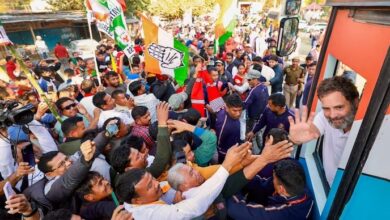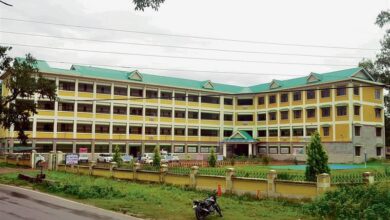Delhi is still under strict security, but farmers promise to keep marching
A day after hundreds of protestors clashed with police forces as they attempted to breach several levels of barricading at the Shambhu border between Punjab and Haryana, security measures to stop a farmers’ march to the capital were still in place on Wednesday.

After at least 110 protestors were hurt in altercations with police personnel that included the deployment of water cannons and tear gas shells, the demonstrators late on Tuesday night promised to continue their march early on Wednesday morning.
In a letter to Prime Minister Narendra Modi on Tuesday, the Samyukt Kisan Morcha, a union of farmers that has called for a statewide strike on Friday, accused the government of attempting to split the agricultural organizations.
Tuesday at 10 a.m., the protestors in trucks and tractors started their march, hours after talks between Union ministers Arjun Munda and Piyush Goyal and farmers on Monday night broke down in impasse. They came together at the Punjabi and Haryana border crossings. The demonstrators attempted to scale security barriers layer by layer as thousands of police officers battled to contain them.
As they advanced through the first stages of blockading, farmers along the borders of Punjab and Haryana—Shambhu and Jind—were targeted by drones dropping tear gas shells.
Jind farmers were charged with batons. After being arrested for many hours, the farmers were freed.
Traffic in New Delhi was hampered by security measures throughout most of the day as 2,000 police officers guarded the borders. According to police, they want to avert a repeat of the bloodshed that occurred in January 2021 when farmers on a protest assaulted the Red Fort.
Prior to the farmers’ march from Punjab, Haryana, and Uttar Pradesh via the Capital, prohibitive restrictions were put into place to limit public gatherings and movement.
In order to regulate the flow of passenger traffic, restrictions were placed outside of at least eight metro stations on Tuesday, according to the Delhi Metro Rail Corporation (DMRC), which cited directives from the Delhi Police. One or more gates were closed. Chaos was brought on by longer lineups at stations, especially during business hours.
Due to roadblocks on major thoroughfares, traffic in several areas of Delhi completely stopped during morning commute hours. Heavy traffic was observed at the main border crossings with Gurugram and Noida.
Pickets obstructing the road caused traffic in downtown Delhi to slow down as well.
At the Singhu flyover, Delhi Police erected roadblocks from the Kundli side, enabling traffic to flow in one lane on each roadway. Haryana-based commuters had to deal with up to an hour-long traffic jam.
As farmers prepared to gather at the border crossings of the Capital on Tuesday afternoon at Singhu, Tikri, and Ghazipur, rows of metal barriers, shipping containers, and concertina wires were erected on Delhi’s outskirts.
Traffic gridlocks extended to major thoroughfares around the city. The Delhi Police alerted commuters to the possibility of traffic diversions “may be required at Singhu, Ghazipur, and Tikri borders depending on the conditions” in an updated traffic warning on Monday night.
At the borders were more than fifty Delhi Police and paramilitary companies, each with advanced weaponry, bulletproof jackets, batons, helmets, and tear gas launchers and shells. Additionally, drones were used over the outskirts of the city.
A complex network of obstacles, including iron barricades, jersey barriers, shipping containers, barbed wire fencing, iron nails, hydra cranes, buses, and other vehicles, was erected at the borders to prevent the farmers who were protesting from reaching Delhi.
Every police station in the city was alerted, and officers were urged to step up car inspections, patrols, and police pickets. On Monday, the police erected checkpoints in the heart of Delhi.
The farmers want employment for the families of those slain during the 13-month-long farmers’ protest between November 2020 and December 2021, as well as minimum support prices for their crops and waivers on farm debts. They also want the proceedings against the protesting farmers to be dropped and compensation for the farmers who were hurt in Lakhimpur Kheri.
In October 2021, four farmers who were protesting were put to death in Lakhimpur Kheri. Minister of the Union Ajay Kumar Mishra Ashish Mishra, Teni’s son, is the main suspect in the mowing.
Cultivators staged one of the largest protests in years in 2020–21, which forced the government to revoke three legislation established in September 2020 to reform agriculture.
For over 14 months, tens of thousands of farmers who were against the legislation camped out on state roads. They disregarded the government’s assertion that the rules would help them by giving them better access to markets and instead effectively established protest townships at five locations, including Ghazipur, Singhu, and Tikri. They also obstructed traffic. The legislation, according to farm groups, would put growers at the whim of businesses.







